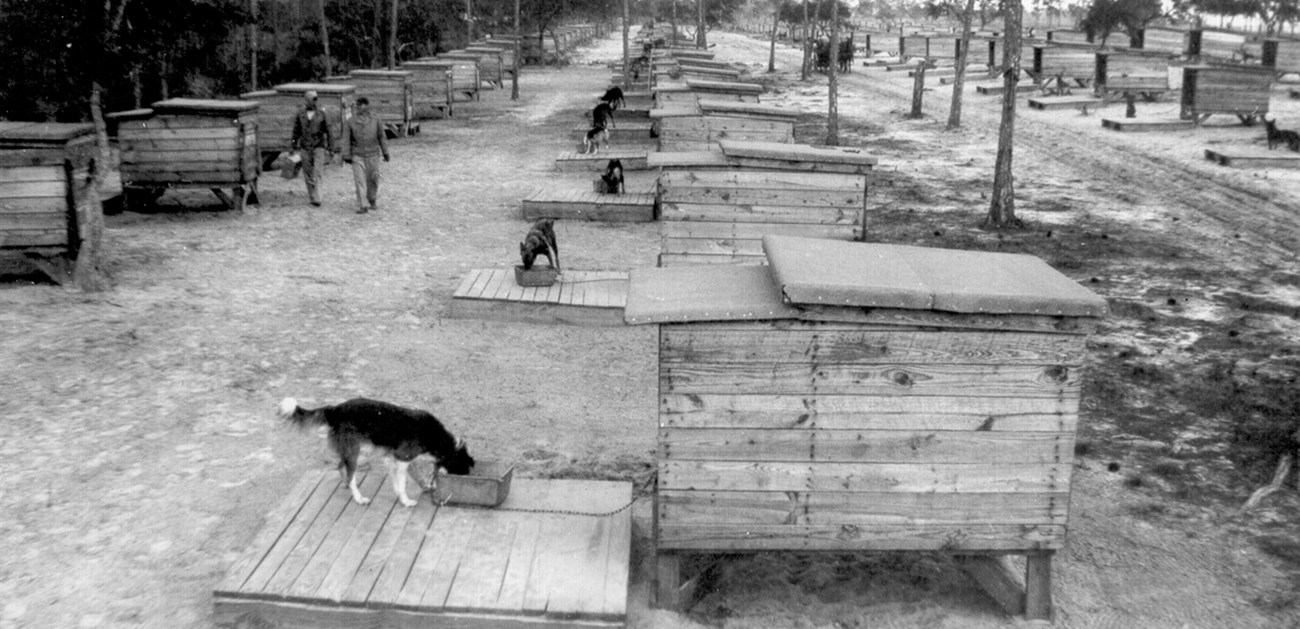
During World War II, dog owners expressed an interest in donating their pets to support the American war effort. This led to the creation of the Dogs for Defense program. This program placed donated dogs into an 8-12-week basic training program. Those that completed the initial training then received specialized training based on their skills and abilities. Cat Island, Mississippi was one of five specialized training centers.
Swiss dog trainer William A. Prestre proposed a new specialized training program based on a belief that dogs could differentiate humans by smell based on their cultural heritage. He believed trained dog packs could track and attack Japanese soldiers in the Pacific Theater. The Army agreed to the proposal and classified it as top secret while the dogs were being trained. The Army leased Cat Island; a private uninhabited island just off the coast of Mississippi. The dense vegetation, ecosystem, and climate of the island resembled the pacific. There were plenty of scrub oaks, pines, lagoons, and marsh grasses for camouflage. Cat Island was the perfect location for this top-secret training facility.
To train the dogs, Japanese Americans, or Nisei (Japanese: “second generation”), from the 100th Infantry Battalion were selected to serve as live targets. The initial drill involved these soldiers hiding in the dense vegetation with a piece of meat. Once found the soldier would fire an air rifle into the air, place the meat against his throat, and fall to the ground. Instead of attacking, the dogs grabbed the meat and licked the soldier's face thinking the meat was a treat. Once dogs completed the first drill, the soldiers would hide without the meat, again the dogs hesitated to attack and “kill” the familiar Nisei, who wore padding for protection. In an effort to get the desired response from the dogs, Prestre ordered the soldiers to hurt them when found.
On January 12, 1943, Prestre demonstrated the dogs progress in front of the Army Ground Forces. What they saw was a series of routine drills and dogs that lacked interest in attacking the Nisei. Prestre got a second chance but produced the same results.
The program failed, primarily due to Prestre’s prejudiced belief that human scent is based on ancestral heritage. Dogs can differentiate between people, but it is due to diet. Nisei were Americans and did not eat the same diet as Japanese soldiers. The failure prompted the shutdown of the Cat Island training center July 15, 1944. Cuevas, John. Cat Island: The History of a Mississippi Gulf Coast Barrier Island. Jefferson, NC: McFarland & Company, Inc. Publishers, 2011.
Golden, Kathleen. “Dogs for Defense: How Skip, Spot, and Rover Went Off To Fight World War II.” National Museum of American History. https://americanhistory.si.edu/blog/dogs-defense.
Nosaka, Ray. “Secret Mission: Dog Training.” http://nisei.hawaii.edu/object/io_1153256967265.html.
Paltzer, Seth. “The Dogs of War: The U.S. Army’s Use of Canines in WWII.” National Museum of the United States Army. https://armyhistory.org/the-dogs-of-war-the-u-s-armys-use-of-canines-in-wwii/. |
Last updated: May 7, 2020
